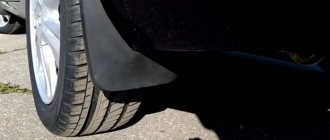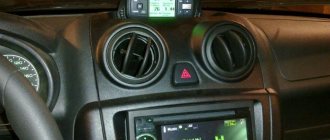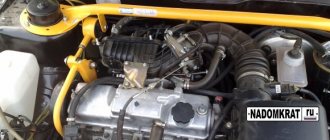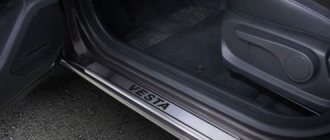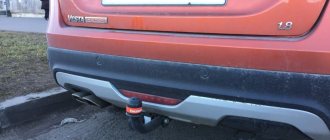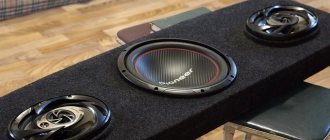Types of mud flaps
Mud flaps (hereinafter referred to as protection) are made of impact-resistant rubber and plastic adapted to temperature changes.
The former are more resistant to damage and wear. The material from which they are made is elastic and does not break when bent, which is very convenient when overcoming road obstacles, uneven surfaces, and potholes.
Plastic accessories are purchased less often than rubber ones. It's not even a matter of price, but the systematic accumulation of dirt and moisture in the grooves of the sidewalls.
Among the advantages of plastic is “holding” its shape when moving at high speeds. At the same time, even a shallow pothole on the road will deform the plastic protection.
The final choice of mudguard remains with the owner of the technical equipment. If necessary, get advice from service station specialists regarding the compatibility of protection with your car model.
Which material to choose
Of course, the most popular and high-quality material used for the manufacture of such spare parts is rubber. It perfectly withstands loads of any type, and is also resistant to vibration and has an elastic shape. In addition, water and dirt do not accumulate on the rubber version of the part, which is a big plus, especially when driving in bad weather.
Unlike a plastic sample, a rubber one can bend, depending on the speed of the car, and not disrupt the overall aerodynamics of the body. But, despite the large number of advantages, rubber, as a material for manufacturing, also has significant disadvantages. For example, over time, it begins to show aging, and as a result, destruction. The average lifespan of a rubber mudguard is 1.5 years. After this, their original functions are lost, and their performance and elasticity are significantly reduced. Also, rubber does not tolerate low temperatures at all, and becomes very fragile and vulnerable.
The plastic version, unlike the rubber one, does not change at all under different weather conditions. It maintains the same condition both in hot summer and in severe cold. But, on such a surface dirt and water accumulate more easily, which is not very good for the body of a Lada Vesta car.
Also, plastic mud flaps are significantly inferior in that when a wheel gets into a hole, they often break off. This also happens quite often when reversing onto a high curb.
Of course, given the fact that the Lada Vesta is a passenger sedan and, by its original purpose, is not at all suitable for off-road driving, the chance of breaking the mudguards becomes much less.
Do-it-yourself rear mudguard installation on Lada Vesta
Necessary tools for work:
- wheel wrench;
- electric drill;
- Phillips screwdriver;
- metal brush;
- new protection kit.
How to install mudguards. Step-by-step replacement guide
- We place the car above the inspection channel.
- We squeeze the handbrake and turn off the ignition.
- Jack up the rear of the car and remove the wheel.
- We clean (rinse) the rear part of the wheel arch where the fender liner is attached.
- Unscrew the two lower screws that secure the fender liner to the car body.
- We apply protection and outline the location of future holes.
- We drill holes with a drill and lubricate them with grease to prevent the development of corrosion.
- We fix the mudguard with self-tapping screws, which are supplied with the accessory.
- We put the wheel on the studs and lower the car into the transport position.
- Do-it-yourself replacement of rear mudguards is completed.
Related link:
Replacing the ignition coil on a Lada Vesta. Recommendations for selection and prevention
How important are mud flaps for a car?
When releasing the Lada Vesta sedan onto the automobile market, the manufacturer AvtoVAZ for a long time doubted the need to equip the car with rear mudguards. Therefore, car owners need to buy them separately from the car itself.
This feature is inherent not only to this model, but also to other modifications of passenger cars of the domestic automobile industry. The outer shell of the car is more exposed to sand, dirt, water and other chemicals that are sprinkled on city road surfaces. As a result of this, the rear part of the body is subject to constant negative environmental influences on the car body.
The listed factors contribute to the rapid appearance of corrosion of the bottom, as well as changes and damage to the paintwork of plastic surfaces (bumper, etc.). Also, when driving at high speed, body elements are exposed to air currents, which are another source of pollution.
It is for these reasons that mud flaps are considered to be one of the most important protective elements of the body.
Review of Manufacturer Prices
| Serial number/catalogue number | Price in rubles |
| AvtoVAZ Rear 99999218001382 | From 1100 |
| Novline 89108-0-147-2689 | From 1100 - 1200 |
| 89109-73-147-2689 | From 1100 - 1200 |
| Guard VS-ZBLV | From 900 |
| Avtodriver AVTMODEL2 | From 900 |
| AVTMODEL1 | From 900 |
| NLF 52.33.E10 | From 900 |
| *prices are as of May 2019 | |
Recommendations and tips for choosing and installing mudguards on Lada Vesta
AvtoVAZ management decided not to equip the Lada Vesta, which is currently the company’s flagship model, with rear mudguards.
This practice is widespread throughout the world and there is nothing unusual about it. Therefore, mud flaps, like many other accessories for the Lada Vesta, will have to be purchased independently. But before shelling out money for this additional element, you should understand how necessary it is for a Russian car.
In addition, you need to be careful when choosing mudguards, as they come in different qualities. This article will also provide instructions for installing these products.
The correct choice of rear mud flaps for the Lada Vesta will not only improve the appearance of the car, but will also protect it from many adverse factors.
The car body will be protected from splashes of water and dirt, so the car will be able to successfully resist corrosion for many years.
But in order for mud flaps to effectively protect your car, they must be correctly selected and installed.
Do you need mud flaps for Lada Vesta?
The absence of this part on the factory version of the car negatively affects the wear resistance of the body and wheel arches of the Lada Vesta.
At high speeds, the air flow causes a variety of different contaminants to be deposited on an unprotected vehicle. Therefore, having rear mudguards can save you from premature aging of your car.
Installation on Lada Vesta
For Lada Vesta you can find high-quality mudguards costing no more than 1300-1500 rubles.
Installing this element yourself will consist of several steps:
- Remove the rear wheel, clean the surface of the arch from dirt, a stiff brush is usually used for this.
- Using self-tapping screws (it is more convenient to use self-tapping screws with a diameter of 4.2 mm and a length of 16 mm), attach the rear mudguard to the car; usually they are accompanied by a diagram according to which you should proceed.
- Two additional holes with a diameter of 5 mm are made independently. It is better to drill them next to the factory ones at an equal distance, one at the top of the mudguard and one at the bottom, immediately after that treat them with an anti-corrosion agent.
Properly selected and installed rear mudguards on the Lada Vesta will reduce the amount of dirt that flies out from under the wheels onto cars driving behind.
By the way, original parts and some other accessories for Lada Vesta are already on sale, which will have a relatively low cost.
But you can also use universal versions of products from companies such as Sparco or Elegant, which will have to be modified at the time of attachment to the car.
Which material is better?
The most popular and in demand material for the manufacture of these parts on the Lada Vesta is rubber. This material can withstand various loads well, it is flexible and elastic, not brittle and brittle. The rubber adapts to any conditions dictated by the track; dirt and water easily drain from them.
Rubber accessories do not affect the aerodynamics of the car, as they adjust and change their position depending on the driving speed. The disadvantage of this material for making mud flaps is that the rubber is prone to aging and wear.
On average, rubber products need to be replaced every year and a half, as they wear out and become unusable. Rubber can change its properties depending on the ambient temperature.
In severe frost, rubber of this type heats up, and such mud flaps often crack and break.
Another option for the Lada Vesta could be plastic linings. The advantage of plastic over rubber is its resistance to any weather conditions. Regardless of the air temperature, plastic mudguards retain the same state of aggregation.
The disadvantages of this material include the tendency to become dirty due to the characteristic shape of the parts. When driving on uneven roads or off-road, plastic mud flaps often break, since they are more rigid than rubber products and are more easily damaged by impacts and strong pressure. Therefore, driving backwards onto a curb or getting the rear wheel into a hole can lead to damage to the plastic.
Bottom line
Most experienced car owners install rear mudguards on Lada Vesta. These simple and inexpensive products can protect your car from many troubles. Mud flaps are very inexpensive and quickly pay for themselves due to effective protection against dirt and prevention of corrosion.
Source: https://VestaTeam.ru/kuzov/bryzgoviki-na-lada-vesta-vybor-i-ustanovka.html
Conclusion
Installing rear mud flaps is necessary and important to protect the wheel arches of the car. Regarding the material of the accessory, this is a personal matter: rubber or plastic. The decision on the choice is made by the owner of the vehicle.
Workers at a number of certified workshops insist on purchasing rubber protection, which will extend the life of the mudguard to several years.
Reviews
| № | Positive |
| 1 | Andrey (Avtodrom): in the third year of operation of the car, I installed mudguards. The process is not at all complicated, but it does not forgive mistakes. |
| 2 | Sergey (Avtotema): I’m pleased with the domestic plastic protection, although my comrades dissuaded me, saying they were impractical in the pits. |
| 3 | Kirill (Autoreview): I’ve been riding on domestic fenders for two seasons now, there are no comments on the quality. |
| 4 | Alexey (Avtoria): I ordered the installation of the fender liner at a service station, the guys completed it in half an hour. Provided a one year warranty on the accessory. |
| 5 | Alexander (Drom): I installed the wheel arch protection on my own, for the first time, I thought it wouldn’t work. Half an hour and the protection is installed. |
| 6 | Stanislav (Driving): the protection is good, practical, and does not deform in the cold. |
| 7 | Vasily Alekseevich (“5th wheel”): I rode on rubber protection for two seasons, there were no problems, I think it will last the same amount. |
| Negative | |
| 8 | Vitaly (Avtotema): the plastic protection burst in the first winter when driving through snowdrifts. After installing rubber ones, the quality is better than plastic, more elastic in the cold. |
| 9 | Svyatoslav (Otzovik.net): the rubber cracked after a year and a half from the date of operation. I don’t know what to do, I’ll buy a new one. |
| 10 | Vlad (ProAvto): there are no particular complaints about the plastic, but in heavy snow a large amount of ice accumulates between the wheel and the wheel arch. |
Related link:
Test drive Lada Vesta Cross
Self-installation
Self-installation of front and rear mudguards on the Lada Vesta will be within the capabilities of a middle school student. Any worker who knows how to hold a screwdriver with a wrench in his hands will quickly deal with the task. The installation process may vary depending on the type of attachment of the mudguard to the body. True, during installation everything is intuitive. We will try to “chew from A to Z” as clearly as possible about the procedure for carrying out such an operation on a Vesta model car. Prepare a wheel wrench, a wire brush, a drill, a jack and a screwdriver (screw in the screws).
Having removed the rear wheel, we clean the surface of the wheel arch from accumulated dirt;
using self-tapping screws, attach the mudguard;
Make 2 holes with a diameter of 5 mm yourself, and later treat them with a special preparation to protect the metal from corrosion. Ignoring the advice, after the first winter the body of your iron assistant will have problems that require painting);
The front mudguards are installed in a similar way; we do not consider it necessary to describe them in detail again.
After completing the installation, the appearance of the Lada Vesta car will be transformed for the better. The body will gain additional protection against loss of presentation. Drivers driving behind will thank you for the reduced amount of water, dust, stones and dirt flying onto their cars. This undoubtedly has a positive impact on road safety.
Description
A set of budget rear mudguards for Lada Vesta from the Yugar company (Tolyatti).
Mudguards are installed in standard places.
The material of the mudguards is TEP (thermoplastic elastomer). TEP is a material that combines the characteristics of rubber and thermoplastic and retains elasticity even at the highest temperatures. TEP does not crack, does not dry out in the sun, and fades for a very long time. TPE is not corroded by acids, alkalis and natural organic matter. The disadvantage of this material is its fragility at temperatures below -45C.
The set includes 2 mudguards, the price is per set.
More details
Description
